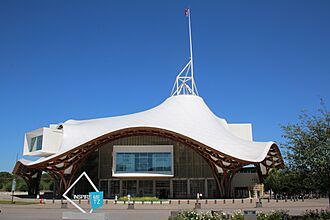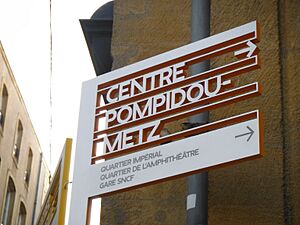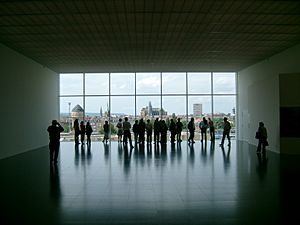Centre Pompidou-Metz facts for kids
Quick facts for kids Centre Pompidou-Metz |
|
|---|---|
 |
|

Centre Pompidou-Metz in August 2017
|
|
| General information | |
| Type | Culture and leisure |
| Location | Metz, France |
| Coordinates | 49°6′29″N 6°10′48″E / 49.10806°N 6.18000°E |
| Construction started | 7 November 2006 |
| Inaugurated | 12 May 2010 |
| Cost | 69.33 million Euros |
| Landlord | Metz city |
| Height | 77 m (253 ft) |
| Technical details | |
| Floor area | 10,660 m2 (114,700 sq ft) |
| Design and construction | |
| Architect | Shigeru Ban |
| Architecture firm | Shigeru Ban Architects Europe |
| Main contractor | Metz Métropole |
| Renovating team | |
| Renovating firm | Demathieu & Bard |
The Centre Pompidou-Metz is a cool museum in Metz, France. It shows modern and contemporary art. Think of it as a younger sibling to the famous Centre Georges Pompidou in Paris.
This museum displays amazing art from the French National Museum of Modern Art. This collection is one of the biggest in Europe for art from the 20th and 21st centuries. The Centre Pompidou-Metz has a huge space for temporary exhibitions, about 5,000 square meters! It includes three galleries, a theater, and an auditorium.
The building was designed by a Japanese architect named Shigeru Ban. Construction started in 2006, and it opened its doors in 2010. One of the most special things about it is its roof. It's one of the largest and most complex roofs ever built, inspired by a Chinese hat!
Since it opened, the museum has become one of the most popular cultural places in France, outside of Paris.
Contents
A Look at the Building's Design
The Centre Pompidou-Metz has a unique hexagon shape. It has a tall spire in the middle that reaches 77 meters high. This height is a nod to the year 1977, when the original Centre Georges Pompidou in Paris first opened.
Inside, there are three rectangular galleries (Gallery 1, 2, and 3). These galleries weave through the building at different levels. They even stick out through the roof! Each gallery has huge windows that point towards famous landmarks in Metz. You can see the Saint-Stephen Gothic cathedral and the Imperial railway station. There's also the Arsenal Concert Hall and the Arènes indoor sport arena.
The main hall, called the great nave, is 1,200 square meters. It's super flexible for showing really big artworks. The ceiling here goes from 5.7 meters up to 18 meters high!
The Amazing Roof
The roof is truly the star of the building. It's a 90-meter-wide hexagon, just like the museum's floor plan. This huge roof covers 8,000 square meters. It's made from 16 kilometers of special glued wood! These wooden pieces cross each other to form hexagonal patterns. It looks just like the woven pattern of a Chinese hat.
The roof isn't flat; it has cool curves and counter-curves all over the building. This is especially true above the three exhibition galleries. To protect this wooden structure, it's covered with a white fiberglass material and a special coating called teflon. This teflon coating is self-cleaning, which is pretty neat! It also protects the building from direct sunlight. At night, you can see through it a bit, which looks really cool.
Gardens and Surroundings
The Centre Pompidou-Metz also has a restaurant with a terrace. The inside of the restaurant was designed to look like a kaleidoscope. The garden around the museum was designed using ideas of sustainable gardening. This means it's good for the environment.
The museum is a key part of a new area in Metz called the Amphitheater District. This district, covering 50 hectares, is a modern area that includes a convention center and a shopping mall. It also has the Seille park and the Arènes indoor sport arena. This whole area was completed around 2016.
The Centre Pompidou-Metz and its front area, called Human Rights square, are built on an old Roman amphitheatre site. This was from the ancient city of Divodurum Medriomaticum, which was the ancestor of today's Metz.
Exciting Exhibitions and Shows
The Centre Pompidou-Metz usually hosts about 3 to 4 special temporary exhibitions each year. You won't see these exhibitions anywhere else! Most of the art comes from the huge collection of the National Museum of Modern Art. This museum has the largest collection of modern and contemporary art in Europe.
The museum also works with other cool museums around the world. These include the Los Angeles County Museum of Art and the Luxembourgian Museum of Modern Art. They often team up for joint projects.
Besides the temporary art shows, the Centre Pompidou-Metz has live performances in its theater. It also holds meetings and talks with famous artists in its auditorium.
Sometimes, the museum building itself and the city of Metz become part of the art! For example, the building's structure was used for a visual art project by French artists. Also, a photographer named Yann Arthus-Bertrand took amazing aerial photos of Metz and the museum for an exhibition called Views from Above.
-
Pablo Picasso's Parade curtain, shown in May 2012 during the "1917" exhibition.
Past Exhibitions
Here are some of the cool exhibitions that have been held at the Centre Pompidou-Metz:
- Masterpieces ? (2010–2011)
- ECHOS, Work in Situ, Daniel Buren (2011)
- Wander, Labyrinthine Variations (2011–2012)
- Bivouac, Ronan and Erwan Bouroullec (2011–2012)
- Echo of Echos: From Above, work in situ, Daniel Buren (2011–2014)
- Sol LeWitt retrospective, wall drawings from 1968 to 2007 (2012–2013)
- 1917 (2012)
- Parade, Pablo Picasso (2012–2013)
- FRAC Forever (2012-2013)
- Lines: a Brief History (2013)
- Sol LeWitt as a Collector, an Artist and his Artists (2013)
- Views from Above (2013)
- Allen Ginsberg and the Beat Generation Reality Sandwiches (2013)
- Dreams of Icarius (2013–2014)
- Paparazzi! Photographers, Stars and Artists (2013–2014)
- Hans Richter: Encounters (2013–2014)
- 1984–1999 The Decade (2014–2015)
- Simple Forms (2014–2015)
- Beacons (from 2014), a special ongoing exhibition
Getting to the Museum
The Centre Pompidou-Metz is right in the middle of Metz. You can easily get there using local public transport. It's also very close to the Imperial railway station of Metz. This station connects to France's fast high-speed train network. You can get a direct train from Paris or Luxembourg!
A train ride from Paris East station to Metz takes about 82 minutes. From France's international Paris-Charles de Gaulle Airport, it's about 75 minutes. If you're traveling by car, Metz is at the meeting point of two big highways: the A4 motorway (from Paris to Strasbourg) and the A31 motorway (north-south).
The "Beacons" Exhibition
The "Beacons" exhibition is a special ongoing show at the museum. It started in 2014 and features 18 amazing artworks. These pieces are usually too big to be shown often, so it's a great chance to see them! All the art comes from the French National Museum of Modern Art.
This exhibition gives you a quick tour of major art movements since the early 1900s. You'll see works from artists like Pablo Picasso, Anish Kapoor, Sam Francis, and Joan Miró. Some of the artworks you might see include:
- Figures and Birds in the Night, by Joan Miró
- Survivors, by Yan Pei-Ming
- Homogenous Infiltration for Piano, by Joseph Beuys
- Reflexions of a Waterfall I, by Louise Nevelson
- Tabula, by Simon Hantaï
- Entrance to the Railway Pavilion, by Robert Delaunay
- Stage curtain for the ballet Mercure, by Pablo Picasso
- Composition with Two Parrots, by Fernand Léger
- Orangey, Light Blue Forms, by Claude Viallat
- Palombe, by Frank Stella
- Painting 202 x 453 cm, 29 June 1979, by Pierre Soulages
- Aware II, 28.3.1961, by Jean Degottex
- Lost World, by Pierre Alechinsky
- In Lovely Blueness, by Sam Francis
- For a Little While, by Joan Mitchell
- Untitled, by Anish Kapoor
- Untitled (to Donna) 5a, by Dan Flavin
- Untitled, by Robert Irwin
The First Big Exhibition: "Masterpieces?"
The very first exhibition at the museum was called Masterpieces?. It showed about 800 amazing artworks, with over 700 borrowed from the Centre Georges Pompidou in Paris. This exhibition made people think about what makes something a "masterpiece." It ran until January 2011 and attracted over 800,000 visitors!
Some of the famous artworks shown included:
- Woman with a Guitar, by Georges Braque
- King's Sadness, by Henri Matisse
- The Aubade, Lying Nude near Musician, by Pablo Picasso
- Guernica, by Pablo Picasso
- Ingres's Violin, a photograph by Man Ray
- Black cross, by Kasimir Malevitch
- Blue I, Blue II, Blue III triptych, by Joan Miró
- Reliefs for the Stairs of the Railway Palace, by Robert Delaunay
- Capricorn, by Max Ernst
- The Background, by Jackson Pollock
- Standing Woman, by Alberto Giacometti
- Sleeping Muse, by Constantin Brâncuși
- The Tropical House, by Jean Prouvé
The exhibition was divided into four parts:
- Great nave: Masterpieces throughout history
- Gallery 1: Stories behind masterpieces
- Gallery 2: Masterpiece dreams
- Gallery 3: Masterpieces ad infinitum
See also
 In Spanish: Centre Pompidou-Metz para niños
In Spanish: Centre Pompidou-Metz para niños





